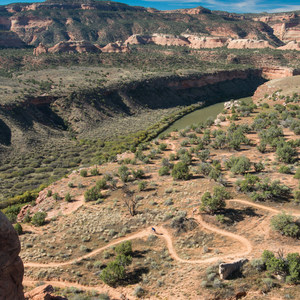You are here
The Rattlesnake Canyon Arches area of the McInnis Canyon National Conservation Area is truly a hidden gem in the high desert country. It is a bit difficult to get to it; the roads require four-wheel drive, and they can be impassable when wet. The views of the several mesas and bench levels are fantastic, however. This site has the second highest concentration of arches in North America, second only to Arches National Park, but without the crowds or the paved roads right up to the arches.
Starting in Grand Junction, Colorado, the drive to the trailhead passes through the Colorado National Monument, which is a great, more accessible site. The dirt road passes through private property, so please be respectful and stay on the road. After some rocky and steep areas that require a high clearance vehicle, the views of the mesas and of the mighty Colorado River open up as the road winds down the high desert. There is space to park at the trailhead, but camping and overnight parking are prohibited.
The first two thirds of a mile are a descent of almost 200 feet, getting down to the top of the mesa where the arches are. At that point, descending to the bench below can be a bit tricky, so make sure to follow the trail (located at 39.141621, -108.838135). Other spots can be very steep and dangerous. The trail descends another 250 feet over 0.25 miles on very rocky terrain, so make sure to bring sturdy shoes. Further, it can be very hot in the summer, so make sure to bring a hat, sunscreen and plenty of water. The hike up to the trailhead can be very difficult at midday if you do not have enough water.
Once down at the lower bench, the trail is mostly flat and goes around the mesa for about 2.5 miles, where you can see various arches and great views of the piñon juniper covered mesas, proof of ancient shallow seas, and millions of years of erosion. Note that, while it is possible to climb back up to the top of the mesa at the end of the 2.5 miles, the route is truly a climb (not just a steep hike), which would require ropes and technical skills. Unless you are prepared for that, plan on walking around the mesa and back (5 miles roundtrip from that point).
The turn point around the tip of the mesa (around 39.147633, -108.852828) offers a view of the rock, which seems like a giant, red and white ship. Shortly afterwards, at about 2 miles from the trailhead, is the first arch: Hole in the Bridge. The hole on the alcove makes for an excellent photo subject. Just under half a mile later is the huge and beautiful Rim Arch. Three-quarters of a mile later is Rainbow Arch. Note that some of the arches appear to have different names, depending on what material you read. On the way back, after hiking to the top of the mesa, it is worth it to explore the arches on the top level.
There are other trails in the McInnins Canyon area, including Rabbit's Ear Trail, Wild Horse Mesa, McDonald Creek, and the over 140-mile-long Kokopelli Trail, which is suitable for mountain biking, and reaches as far West as Moab, Utah. The 123,430-acre national conservation area does not generally experience heavy transit, thus is a great setting to experience solitude and enjoy nature. Please do not remove rocks or petrogyphs, so future visitors and generations can continue to enjoy this wonderful place.










Comments
Sign In and share them.